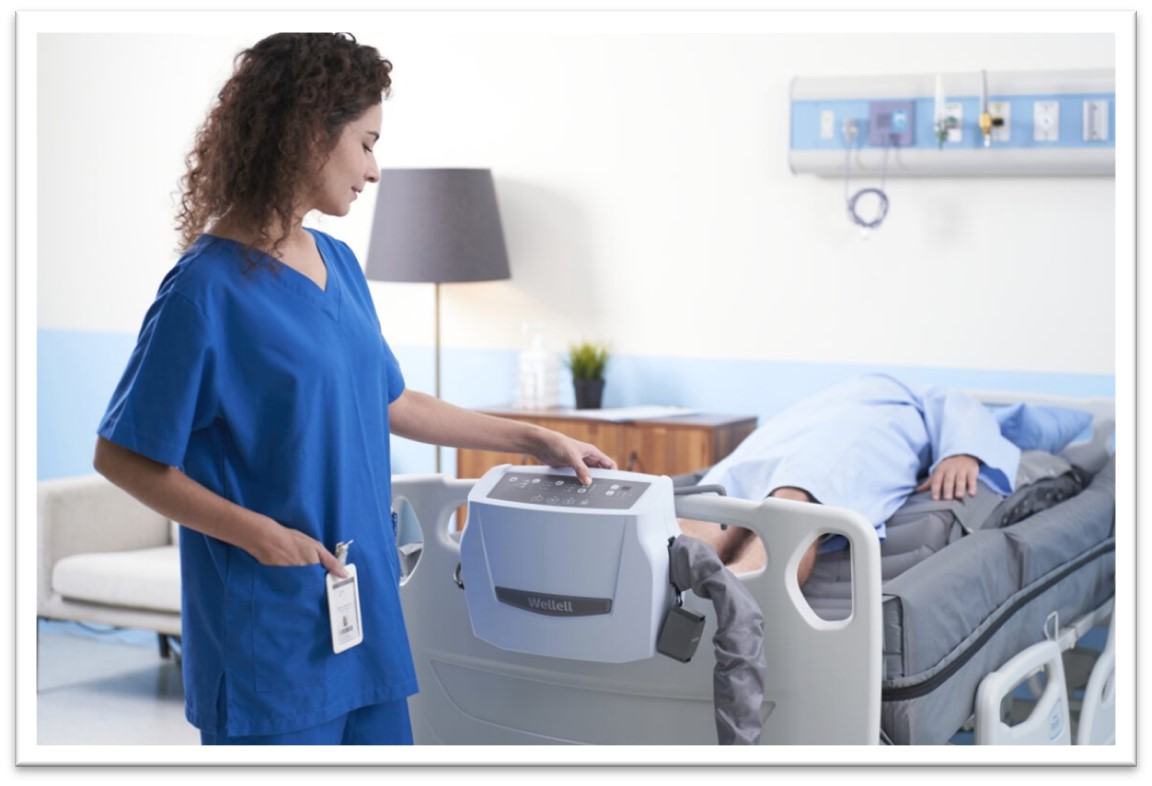How does an automatic turning mattress reduce manpower costs in healthcare?

Pressure injuries are internationally recognized as a crucial quality indicator, and the majority of them are avoidable. Due to limited public and healthcare budgets, there is increasing attention on the costs associated with pressure injuries.
Preventing pressure injuries saves on overall expenses
Pressure injuries are defined as localized injuries of the skin and/or underlying tissue over a bony prominence due to pressure and shear (NPUAP & EPUAP, 2019).1 Pressure injuries are internationally considered as an important quality indicator, and most pressure injuries are avoidable. The costs of pressure injuries are receiving increased attention because of limited public and healthcare budgets. Cost of pressure ulcer prevention and treatment differed considerable between studies. Although the cost to provide pressure ulcer prevention to patients at risk can importantly impact health care services' budgets, the costs to treat a severe pressure ulcer were found to be substantially higher. (Demarré et al., 2015). 2
|
pressure injury prevention |
pressure injury treatment |
|
|
cost of per patient per day(mean) |
EUR 15.7-87.57 |
EUR 1.71-470.49 |
Demarré L (2015) examined the cost of pressure ulcer prevention and treatment in an adult population in hospitals and nursing homes from the healthcare payer perspective.3
|
hospitalized patient |
nursing home resident |
|
|
cost for pressure ulcer prevention per patient at risk (mean) |
EUR 7.88 |
EUR 2.15 |
|
cost for pressure ulcer prevention per patient not at risk (mean) |
EUR 1.44 |
EUR 0.5 |
Clinical recommendations suggest a bi-hourly turning schedule for patients using a standard mattress. However, a high effort and time requirement significantly increase maintenance difficulties, especially in critical care settings.
In acute care, frequent tests, procedures, treatments, therapies and other tasks decrease caregiver' adherence to a rigid turning schedule and repositioning care from priorities.4,5 Staff shortage leads to a lack of time, resources, equipment, and trained caregivers, significantly reducing pressure relief care capabilities.6
1. Decrease Labor-Intensive Workload:
Turn-assisting support surfaces reduce caregivers' workload and labor intensity by up to 20% during a partnered log rolling maneuver. 7,8
2. Technology Integration:
Alternating Pressure Mattress/air mattress to alleviate the burden on caregivers and ensure consistent repositioning for patients. 3. Repositioning Prioritization and Workflow Optimization:
Prioritize pressure injury prevention within the care routine. This might involve rearranging tasks or workflow to ensure that repositioning and pressure relief are consistently addressed. If want to know about Optima Turn
https://www.wellell.com/en/products/optima-turn
Discover the range of Wellell's pressure relief mattresses
Explore the Impact of Pressure Injuries on your hospital
https://www.wellell.com/en/how-can-we-help
- Related Article:
Repositioning Patients to Prevent Pressure Injuries
- National Pressure Injury Advisory Panel. (2019, March 13). Pressure Injury Prevention--Repositioning Frequency. Npiap.com. https://npiap.com/store/viewproduct.aspx?id=14123202
- Demarré L, Van Lancker A, Van Hecke A, Verhaeghe S, Grypdonck M, Lemey J, Annemans L, Beeckman D. The cost of prevention and treatment of pressure ulcers: A systematic review. Int J Nurs Stud. 2015 Nov;52(11):1754-74. doi: 10.1016/j.ijnurstu.2015.06.006. Epub 2015 Jun 25. PMID: 26231383.
- Demarré L, Verhaeghe S, Annemans L, Van Hecke A, Grypdonck M, Beeckman D. The cost of pressure ulcer prevention and treatment in hospitals and nursing homes in Flanders: A cost-of-illness study. Int J Nurs Stud. 2015 Jul;52(7):1166-79. doi: 10.1016/j.ijnurstu.2015.03.005. Epub 2015 Mar 14. PMID: 25862410.
- Krapfl, L. A., & Gray, M. (2008). Does regular repositioning prevent pressure ulcers?. Journal of wound, ostomy, and continence nursing : official publication of The Wound, Ostomy and Continence Nurses Society, 35(6), 571–577. https://doi.org/10.1097/01.WON.0000341469.33567.61
- Moore, Z., & Price, P. (2004). Nurses' attitudes, behaviours and perceived barriers towards pressure ulcer prevention. Journal of clinical nursing, 13(8), 942–951. https://doi.org/10.1111/j.1365-2702.2004.00972.x
- Etafa, W., Argaw, Z., Gemechu, E., & Melese, B. (2018). Nurses' attitude and perceived barriers to pressure ulcer prevention. BMC nursing, 17, 14. https://doi.org/10.1186/s12912-018-0282-2
- Skotte, J., & Fallentin, N. (2008). Low back injury risk during repositioning of patients in bed the influence of handling technique, patient weight and disability. Ergonomics, 51(7), 1042–1052. https://doi.org10.108000140130801915253
- Budarick, A. R., Lad, U., & Fischer, S. L. (2020). Can the Use of Turn-Assist Surfaces Reduce the Physical Burden on Caregivers When Performing Patient Turning?. Human factors, 62(1), 77–92. https://doi.org/10.1177/0018720819845746

